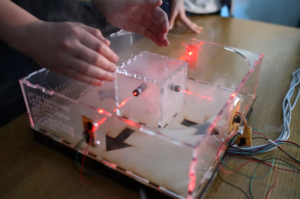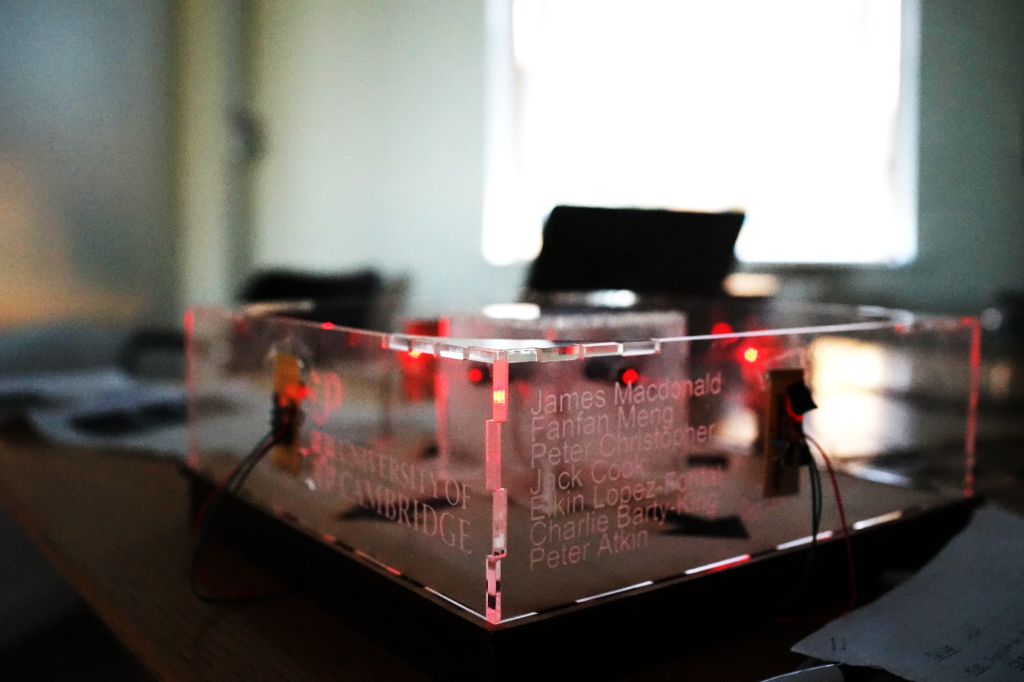TUESDAY, 13 FEBRUARY 2018
Each year over 1000 visitors pass through the main doors of the Institute for Manufacturing for the Cambridge Science Festival; around 300 laser-engineers-of‑the-future make it into the laboratories of the Centre for Industrial Photonics. Among the many exhibits was the laser video game controller developed by the MRes Ultra Precision CDT (Centre for Doctoral Training) students. In this article, we talk about the concept and inspiration of the system, how it works and what happened on the day. Finally, we touch on the relation of this device to future, optically controlled, computer‑human interface devices.The design emerged from a fusion of what had been separate ideas; initial discussions for an exhibit involved the creation of puzzles with blocks and mirrors shifting through laser beam pathways and laser harp instruments with laser beams imitating strings. One team member suggested that building an exhibit which imitated a game controller could be more entertaining without the requirement for musical literacy – from there, it was an easy step into the world of 80s video games and virtual truck racing.
Fundamentally, lasers are useful for transmitting signals because of their highly focused and highly controllable physical nature. Lasers have been tested in space to send signals over hundreds of thousands of kilometres and are widely used as transmitters in modern fibre‑optic communication systems. Whereas a button press on a traditional Xbox game pad controls the flow of electricity, the laser game controller we made mimics this action by disrupting the paths of laser light.
The system works by coupling a four-directional set of laser beams to positionally opposing light sensors. The player moves their hand in front of the beams to disrupt the path between beam source and sensor. The processing circuit then compares the reading from the beam sensor to a second measurement for the ambient light level. Without obstruction the beam sensor will have a much higher reading of light intensity as the laser points directly at it. When a hand disrupts the beam both sensors will measure an equivalent light intensity, this causes a device comparing the readings of the two sensors to output a digital ‘1’. This signal feeds into an Arduino microcontroller; the microcontroller interprets this information and sends command keys to a computer via USB, replicating arrow key presses on a keyboard. This process is then repeated 200 times per second for each of the four ‘laser switches’.

Laser light is highly collimated; this means that the light rays are very close to parallel and do not spread out, so the rays do not reach observers eyes when travelling through the air unless they are looking directly into the beam (which would be incredibly dangerous). This means the only way to see the beam of a laser is for it to reflect or be scattered. In this case smoke was used as the reflective medium, feeding through the base of the controller and pouring into the paths of the beams. To maximise the visual impact, the casing was made from a transparent plastic material. One or two problems were encountered during construction, for example when the smoke machine was tested the internal electronics became soaked with condensation . The solution came from a chance passer-by with experience in marine robotics, who suggested water-proofing the circuit boards with balloons!
 Deft hands hover over the controller
Deft hands hover over the controllerOn the day of the science festival, the system was received as a resounding success. Although we were nervous for the transition from testing on Cambridge PhD student to kids (read: laser engineers of the future), we quickly got into the swing of things and the high scores came rolling in. We have to commend the particularly competitive brother who sabotaged his siblings’ run through cunning use of the smoke machine. Science outreach is great fun and I would hugely recommend getting involved to anybody.
http://www.sciencefestival.cam.ac.uk/get-involved/volunteer

James Macdonald is a research student at the Department of Engineering in Cambridge.
Title image: flickr
Other images: Wikimedia Commons and the author.
